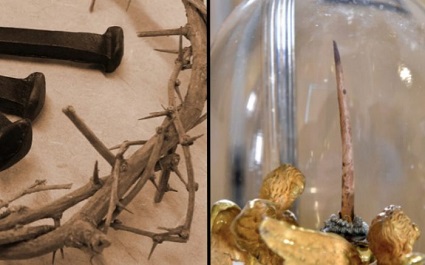 The relic of the Holy Thorn kept in Italy’s Cathedral of Andria changed color, according to Bishop Luigi Mansi of the Archdiocese of Andria, Italy. The relic belongs to Jesus’ original crown of thorns. The Cathedral of Andria held the relic “since 1308, as many know, a distinguished Relic of the Passion of Christ, consisting of one of the thorns that formed the crown placed on the Savior’s head,” Bishop Mansi said.
The relic of the Holy Thorn kept in Italy’s Cathedral of Andria changed color, according to Bishop Luigi Mansi of the Archdiocese of Andria, Italy. The relic belongs to Jesus’ original crown of thorns. The Cathedral of Andria held the relic “since 1308, as many know, a distinguished Relic of the Passion of Christ, consisting of one of the thorns that formed the crown placed on the Savior’s head,” Bishop Mansi said.
According to Tradition...
Tradition says that the relic’s appearance changes when the Solemnity of the Annunciation of the Lord (March 25) falls on Good Friday. On those occasions, as the Archdiocese of Andria comments, “the Holy Thorn suddenly changes its appearance and undergoes transformations.”
In the past, “drops of blood liquified, reviving of the color of the spots on the [thorn’s] Spine,” and “the appearance of silvery whitish growths of a few millimeters,” and “even unexpected flowering” occurred.
What happened during Holy Week 2020?
Because the churches are closed and the cathedral is empty, Bishop Mansi took the Holy Thorn relic to the private chapel of the episcopate, where he celebrates daily Mass. “From the first days of Holy Week, observing the state of the relic, I noticed it showing a different color than usual and, in particular, that it became somewhat lighter,” Bishop Mansi said in an April 18 statement.
For this reason, the bishop said he invited Dr. Antonio Riezzo and Dr. Silvana Campanile to observe the thorn. These specialists live near the episcopate, and were members of the Special Medical-Scientific Commission. Along with additional observations from other clergy, Bishop Mansi said “what has happened below is well testified by five reports from time to time drawn up by me and by the history prepared by Dr. Silvana Campanile. These documents are deposited in the archives of the Episcopio.”
Why did the relic change color?
According to the bishop, this is not the first time that the Holy Thorn became an instrument of a prodigy. Something similar happened when the dates of the celebrations coincided in 2005 and 2016. Traditionally, March 25 (the Solemnity of the Annunciation) falling on Good Friday “represents Christ as the light coming to illuminate the world, but also the true immolated Lamb redeeming humanity and restoring its fullness freedom.”
However, the Solemnity of the Annunciation of the Lord and Good Friday did not fall on March 25 this year. The thorn suddenly changed color during Holy Week. Why? Bishop Mansi: “The Lord does not abandon us. While we intended on celebrating the mystery of Christ’s redemptive suffering, we understand that the Lord does not abandon us, but in a way in particular he wanted to show his closeness in this hour of trial that, as a Church and as a world, we are living enveloped in worry and fear,” the bishop said.
Christ's Passion and Ours
“Many of our brothers and sisters suffer in many ways: the disease in one’s own flesh or in that of one’s family and friends, the death of loved ones and the impossibility of accompanying them… living for weeks now isolated in homes… having to give up going to church for prayer and sacramental celebrations.
“I believe that the Lord wanted to tell us that his Passion continues in the pain of many men and women around the world. But also that this Passion, like yours, however painful, is a penultimate word, because the last is always a word of life and hope. It is the word of Easter, of the Resurrection, of Christ’s victory over death and of the redemption of all humanity.”
Lord, please have mercy on us and deliver us from this pandemic!
+JMJ+
Article Copyright © ChurchPOP. All Rights Reserved. Original article here.
Author Copyright © ChurchPOP Editor. All Rights Reserved.
Image: PxFuel, Public Domain / Diocese of Andria, Screenshot.
Mass Cards: Request Perpetual Mass Enrollments or Mass Intentions or Gregorian Masses for Loved Ones.
Our Catholic Faith: Catechism of the Catholic Church (Vatican Website)
Watch all of our 2-minute, family life videos on the Eternal Word Television Network (EWTN).




